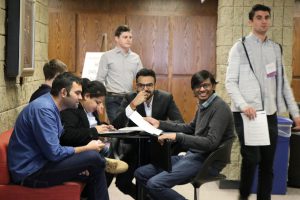By Lily Qi
Medill Reports
After receiving another job rejection, 22-year-old Dayan Paiewonsky posted an Instagram screenshot of the email with “thank u, next.”
Paiewonsky left the Dominican Republic four years ago to study international business and finance at the Loyola University Chicago.
With graduation approaching this summer, finding a job is becoming urgent for him. In Paiewonsky’s eyes, completing college in less than five months isn’t something to be excited about like fellow students, but a crucial stepping stone if he hopes to stay in the U.S.
He started applying for jobs last October, Paiewonsky said. “Nothing has panned out yet. I got a good number of rejections,” Paiewonsky says. “Even for internships, with a lot of internship programs [the company’s] goal is to train people so that they can become entry level.”
Paiewonsky is qualified to meet every requirement most companies have set for jobs in the field of consulting, but companies still don’t hire him due to non-sponsorship policies and an unwillingness to pay visa fees for international students, he says.
Under the current policy of the Department of Homeland Security (DHS), a sponsor company needs to file the petition on behalf of the employee for a visa, including paying the legal and application fees. The total cost of filing an application is about $5,000 per employee.

A company also needs to prove they have enough cash flow to support a foreign worker for a certain period of time and file a Labor Condition Application (LCA) with the U.S. Department of Labor to indicate hiring a foreign worker won’t affect U.S. workers.
Only 85,000 H-1B visas are assigned by lottery for such workers every year while the applicants number more than 190,000 annual applications. Of the 85,000, 20,000 are reserved for applicants holding at least a master’s degrees.
That gives a student such as Paiewonsky, who will have an undergraduate degree, a 30 percent chance to “win the lottery.”
Paiewonsky has access to one year of Optional Practical Training (OPT) that gives him a temporary working permit after graduation even without visa. So, even if he finds a job and gets sponsored for a visa, he only has one chance at the annual lottery to get an H-1B visa.
Things are better for Rong Su, a Chinese student who will complete her master’s degree in computer science at the Northeastern University this December. As a STEM (Science, Technology, Engineering and Math) student, she can work for a three-year OPT term, allowing her two more tries than Paiewonsky has to win in the visa drawing.
Growing demand for highly skilled workers in the tech industry is another obvious reason for the popularity of STEM students in the job market. A report by National Foundation for American Policy points out that the top H-1B employers are all tech companies.

“I won’t have difficulty in finding a job in the U.S., they are not ‘we don’t want you’,” says Su. “It proves the market is big and has growing potentials.”
For Paiewonsky and Su, coming to the U.S. is a pursuit of better income and future career development.
“I knew that whatever area I went into was not going be in one of those traditional careers like doctor, lawyer, engineer or business because I always have a more international approach,” says Paiewonsky, who wants to work as a consultant for multinationals. Fewer opportunities for such a profession are available in the Dominican Republic.
The reason Su wants to stay is direct and simple – the median salary for a software engineer in the U.S. is about $83,000 per year while in China it is only around $27,000, not to mention other employee benefits. It’s normal for Chinese employees to work extra hours without overtime pay.
In 2017, there were 27.4 million foreign-born workers in the U.S. labor force, accounting for 17.4 percent of the total. According to a Pew Research Center report, 30 percent of U.S. immigrants have bachelor’s or higher degrees.
Su confessed she never thought about it what would happen if she can’t stay in the U.S.
“No, I don’t have a plan. I’m going to have a job,” she says.
On the other hand, Paiewonsky seems uncertain. He has many back-up plans and most of them are based on the assumption that he is probably not going to get a job in the U.S.
“I’m looking forward to using the OPT to work here for a year and my plan-b is to move to Panama and work for one of the transnationals there,” he says.


